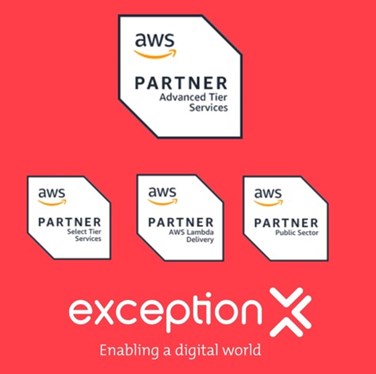By Neil Campbell, Exception Head of Cloud and Cyber
“Science and technology revolutionise our lives, but memory, tradition and myth frame our response.” So said American historian, Arthur M. Schlesinger.
But what about when framing your decision to invest in the cloud? It’s important to do so not based on myth and tradition, but on proven methodology to achieve maximum return on investment.
Many organisations have successfully invested in the cloud to revolutionise their operations, while others have decided not to. This might be because they falsely believe the time is not right, or they remain unconvinced of the technology’s many brilliant benefits.
As an AWS-certified partner, Exception has successfully used AWS cloud services to bring these benefits to its customers in terms of security, operational efficiency, sustainability and cost reduction.
It may seem obvious, but the first precept is to “start the right way”. Drawing on just memory and tradition, organisations are often pressured to “start now”, “start with what you know” or “start with the less risky.”
In turn, this makes starting any strategy and roadmap to cloud adoption difficult.
1. Deploy AWS technologies to make your cloud migration as successful possible
Maximise the use of AWS cloud services but don’t build on your own: We often hear arguments about vendor lock in or bespoke functionality, but these arguments rarely stack up long term for organisations. The AWS Well-Architected Framework enables organisations to understand the pros and cons of decisions they make, while systems are built on AWS. Under the framework are architectural best practices for designing and operating reliable, secure, efficient and cost-effective systems in the cloud.
AWS offers a broad set of global cloud-based products from compute and storage to databases, analytics, networking and developer tools. The key is to build exactly the solution needed, minimising development costs, time and resource, whilst reducing the amount of time your cloud remains idle.
Assume everything will change and design accordingly: Exception adopts a modular approach to Solution and Service Design to minimise the impact of any change (including associated risk, cost and timescales). This allows us to change/iterate the solution at pace, using a Proof of Concept (POC) to validate technology and process requirements. We continually utilise new technologies/services and methodologies through AWS serverless technology to reduce the level of friction in change.
Automate everything: We use AWS automation to maximise the use of cloud services. This enables us to utilise, security detection/protection and self-healing to create reliable, scalable and secure solutions to make operations cost-effective. The result? Automation helps ensure we embrace change rather than resist it. Deployment, testing, verification and issue rectification are then in an automated pipeline for continuous integration/ delivery, ensuring the effort for change is focused.
Ensure stakeholders are aware: Ensure they understand why you are embarking on a cloud adoption or migration strategy and why. The tech industry is vast, and people have very different views on what the cloud is and how it should be used. These variable perspectives, while valuable in deciding what to, do can be disruptive during delivery.

2. Maintain momentum to ensure successful cloud delivery
What processes help maintain project momentum throughout the delivery once a cloud transformation strategy is underway? The process starts with managing the stakeholders to ensure everyone’s needs and perspectives are understood – but they must be kept informed of dependencies and changing scope throughout the project.
Successful cloud adoption or migration delivery thrives on a combination of Exception’s experience and expertise, plus the customer having a clearer organisational vision as possible. But project delivery methodologies must be pragmatic. Any delivery can be plagued with issues regardless of the methodology used such as Agile, Waterfall, TOGAF, CAF or AWS WAR. It is therefore critical to establish which combination or variation of these best meets your project needs. Utilisation of Agile for daily Project Management in combination with fixed price, outcome-based procurement can be successful, but the best path forwards must be pragmatic.
Remember, assume that “project or scope creep" all too often occurs. Identifying project scope through an effective Discovery, Scoping and Engagement phase is key to reducing any bumps in the road later down the cloud transition journey.
A key issue often overlooked in modern Cloud Native Delivery is testing. This includes code level tests that are run through automation or User Acceptance Testing (UAT) to ensure the customer is satisfied with the product. Automated Regression Testing also identifies that any changes have not undermined the quality of the solution.
Manage Technical Debt to deliver quality, not rushed delivery. If you ignore Technical Debt, organisations will end up with a cloud solution that become less and less viable over time. For CxOs, it is critical to ensure that a portion of their delivery is focussed on Technical Debt. Digital Transformation specialists conduct Technical Debt Assessments. Whether this is 5% or 30% of their effort, it must be used and not de-prioritised behind an ever increasing demand for features.
3. Hindsight is 2020 – learn from experience for best cloud delivery pay back

The final question to ask is what could you have done better to make cloud delivery a success?
A delivery which takes several months will inevitably see new solutions, processes and standards emerge but will not be forever in development. Agility is key: And this depends on continually refining an Agile and responsive approach and maximising use of the many AWS solutions.
Review past ways of working to improve future ones. They can be conducted throughout the development life cycle after each Sprint, or at end the entire project to share what went well, what didn’t go well and what should stop/continue.
Critical summary points to drive cloud return on investment:
- Invest in the expertise – whether these are basic skills to understand what you need from the supplier or deep technical skills to do it yourself
- Allow the cloud providers such as AWS do the heavy lifting and build on top of their service
- Create loosely coupled, modular solutions which can absorb change more easily
- Automate everything to achieve development efficiencies
- Make sure the stakeholders understand what you are doing and why
The key to driving return on investment and revolutionising cloud native solutions is this: start right, plan properly, prepare for inevitable bumps in the road and continually learn from your experience.
Only then can you empower your transition to the cloud. But never do so based on tradition and myth. Start with real world proven methodologies that can achieve actual results and add massive value to your transition to the cloud.
Find out more about our AWS specialisms

